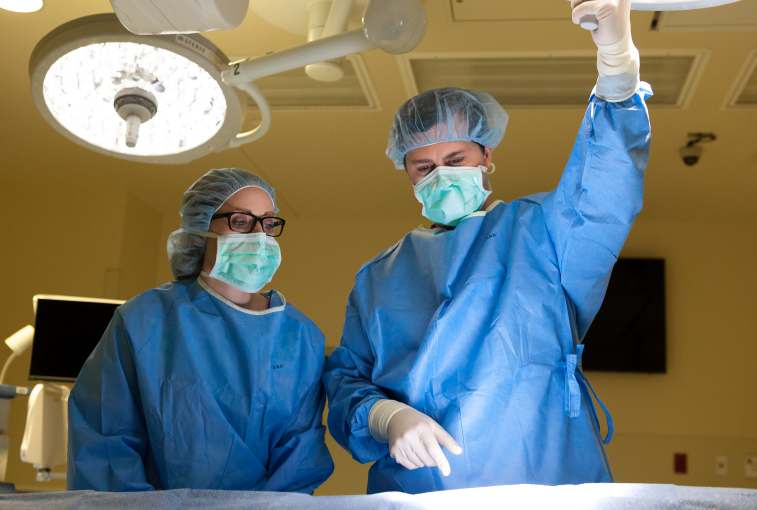Two Sanford Health physicians who invented a device that could simplify stroke treatments have launched a startup company to develop and market the technology. There are approximately 800,000 strokes in the U.S. every year.
The goal is to streamline the current bulky procedural setup with an ergonomic, simple system. That may allow more vascular specialists to perform the intervention to clear blockages from blood vessels in the brain, which could reduce the chance of disability or death or reduce rehabilitation time.
“We feel that we can make stroke intervention safer and quicker. Hopefully easier for the operator and safer for the patient,” said Thomas Haldis, D.O., an interventional cardiologist and medical director of the cardiac lab at Sanford Health in Fargo, North Dakota. He and neurosurgeon Alexander Drofa, M.D., came up with the idea.
They worked with the Sanford Health commercialization team to prototype and patent the invention and now to launch their startup company called Flotronic Solutions. The next step is to finalize and test the prototype in preparation to submit to the Food and Drug Administration.
“Startup is something very exciting, number one. But at the same time it comes with significant risks. So we do have to be very calculated about our steps, our decision-making process, what we need to implement, what kind of changes to the prototype we need to implement. I do also believe we have all the necessary people onboard,” Drofa said.
Startup program
The commercialization team recently created the Sanford Express Startup program. It enables Sanford Health employees to commercialize their intellectual property through a startup company they form or are involved with.
A key component is an express license. It’s designed to be fair both to Sanford Health and the startup founders while also having terms that will draw private equity investments. With a standard set of terms, the founders can start building the company and their product immediately rather than negotiating the license.
Heart and stroke similarities
Haldis said after starting to work with Drofa on stroke intervention, he realized there are a lot of similarities to heart surgery.
“It turned out to be a really complex procedure because of equipment needed. The more I would perform the procedure, the more I would think, ‘There must be a simpler way.’ I began brainstorming how those catheters could be turned into a simpler system,” Haldis said.
“I also noticed the tools — while cutting edge — they seemed imperfect and incomplete. From there, Dr. Drofa and I created the Slide Guide Catheter.”
The investigational device combines two interventional catheters: a guide catheter to navigate near the occlusion, or blockage, and an intermediate catheter capable of suctioning out clots or deploying interventional devices such as a stentriever.
The current approach to repairing strokes requires the use of both of them with a bulky setup for the interventionalist. But the Slide Guide Catheter is intended to combine both in a system specifically designed for navigating challenging anatomy.
That creates several potential benefits over the status quo:
- Less complexity in setup for an acute stroke repair
- Fewer devices needed on the catheterization lab table
- Reduced lab time
Future of interventional stroke care
The Slide Guide Catheter builds on current tools used during a stroke intervention procedure. The innovation would allow surgeons to use fewer devices, which should make the surgical process more approachable and less cumbersome.
“The slide guide has the potential to speed up the procedure and may make it safer. Because it is simpler, we hope to open it up to other specialists,” Haldis said.
Typically, cerebrovascular neurosurgeons or neuro interventionalists are the only doctors who perform interventional stroke interventions. The issue is that there are about 500 of them in the U.S. and nearly 70,000 blood vessel blockages that would qualify for the procedure.
The Slide Guide Catheter may allow more interventional cardiologists, interventional radiologists, vascular surgeons and other specialists to repair many of those untreated strokes.
“Right now, there are not enough interventional neurosurgeons for the number of patients who need a stroke intervention procedure,” Haldis said. “But, as interventional cardiologists, we can learn how to perform these procedures.
“If we can streamline the process with the Slide Guide Catheter and other innovations currently in development, other doctors may be able to step in to help patients in need across the U.S.”
‘Driven to succeed’
When the two physicians came up with their initial ideas, they discussed starting their own company and talked to outside investors about the potential. Ultimately, they connected with the team at Sanford Health that helps physicians, researchers and others develop their intellectual property.
“They have a lot of experience, a lot of knowledge with regards to startups and technology and the patent process,” Haldis said. “Now is the time for Dr. Drofa and I to start this company and push the project through.”
“By starting the company, we are the ones completely responsible for the development of this product. But at the same time, we are very driven to succeed,” Drofa added.
Sanford Health values the ideas and problem-solving ability of its physicians, researchers, clinical workers and support staff. Any employee with an idea for a device, therapy, software, tool or other method that helps patients is encouraged to contact the commercialization team and join the hundreds of people at Sanford Health who are already inventing.
Learn more
- Heart screenings protect against disease, save lives
- Clinics share best pandemic ideas on new crowdsourcing tool
- Collaboration helps Sanford Health test new technology
…
Posted In Brain & Spine, Heart, Innovations, Specialty Care
